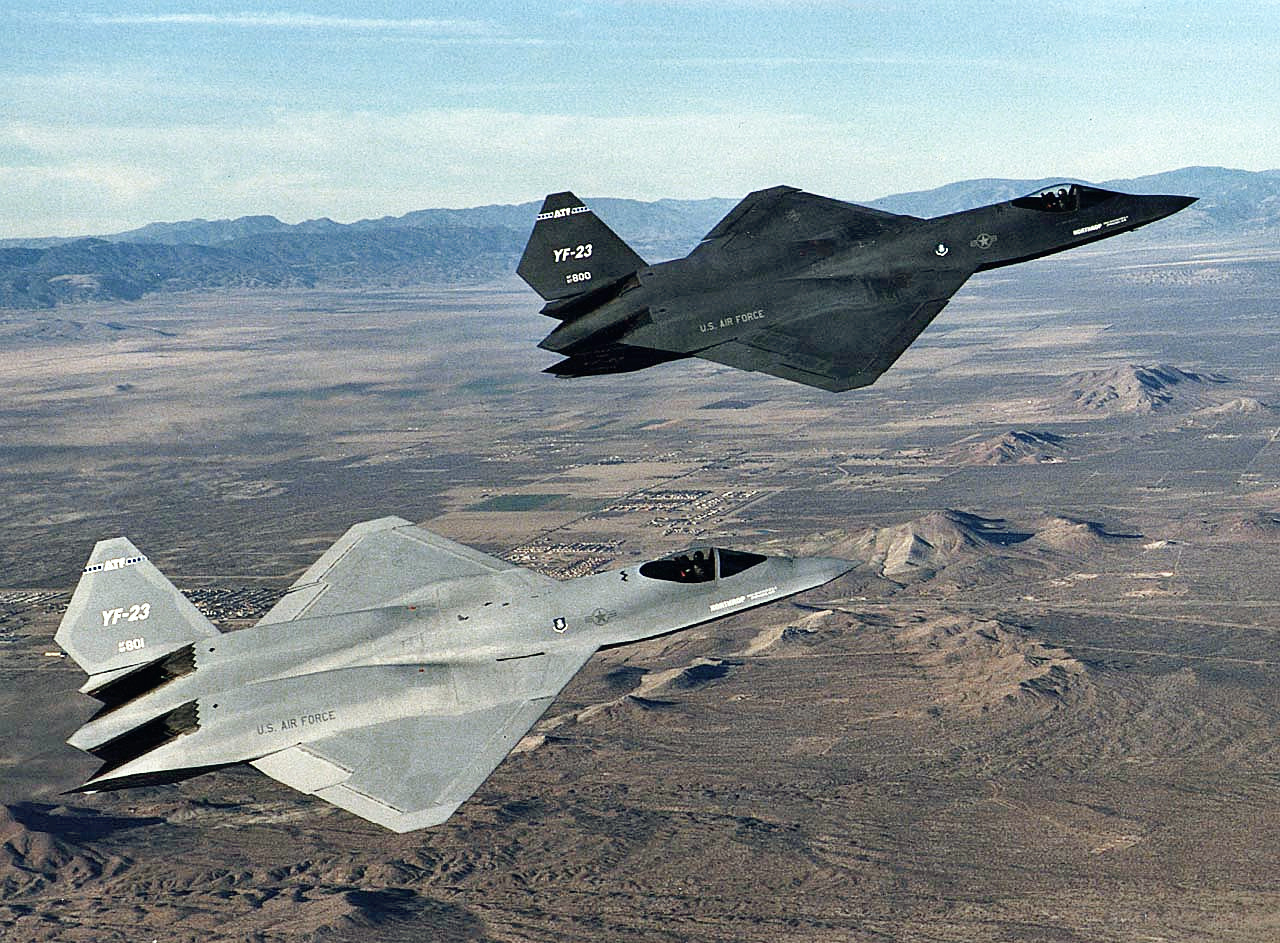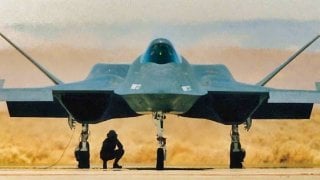YF-23A vs. F-22A: The Untold Story of America's Ultimate Fighter Jet Showdown
The Northrop/McDonnell Douglas YF-23A "Black Widow II" and the Lockheed Martin/Boeing/General Dynamics-designed F-22A "Raptor" were both contenders in the 1980s Advanced Tactical Fighter (ATF) Program aimed at outmatching Soviet capabilities
Summary: The Northrop/McDonnell Douglas YF-23A "Black Widow II" and the Lockheed Martin/Boeing/General Dynamics-designed F-22A "Raptor" were both contenders in the 1980s Advanced Tactical Fighter (ATF) Program aimed at outmatching Soviet capabilities. Despite the YF-23A's superior speed, range, and stealth, the Air Force selected the F-22 for its maneuverability and dogfighting abilities amidst Cold War tensions. However, the evolving threats of the 21st century, highlighting the need for longer ranges and greater speeds, suggest that the YF-23A's design may have been more forward-thinking. Today, the YF-23A's influence is seen in next-generation aircraft designs, hinting at its enduring legacy in military aviation innovation.
The Legacy of the YF-23A: How It's Shaping the Future of U.S. Air Dominance
The Northrop/McDonnell Douglas YF-23A “Black Widow II” was a finalist for the 1980 United States Air Force Advanced Tactical Fight (ATF) Program. Its primary challenger was the Lockheed Martin/Boeing/General Dynamics-designed F-22A “Raptor.”
The Air Force’s ATF program was designed to push the limits of American military aerospace capabilities and, in the process, develop a next-generation warplane that would far outstrip anything the Soviet Union (America’s primary threat at the time) could develop and deploy against the Western alliance.
Both the YF-23A and F-22A were lightyears ahead of their time.
Ultimately, the Air Force chose to go with the F-22 as its next, fifth-generation air superiority fighter. Even today, the F-22 is considered the most advanced manned warplane in the world. What’s more, in every wargame where the F-22 is deployed, the presence of even two F-22 Raptors tips the balance of the engagement in favor of the US side.
Why Not the YF-23A?
The YF-23A was unlike anything that the Air Force had seen. It had a delta-wing shape. Its speed and range were second-to-none. The Black Widow II possessed an incredible stealth capability as well. But the engineers at Northrop/McDonnell Douglas were not necessarily following the parameters that the Air Force had put down for the ATF Program. Since the YF-23A was supposed to be an “Air Superiority Fighter,” it was intended to be a dogfighter.
Go back to the 1980s. Lift your blinders about how Star-Spangled Awesome Ronald Reagan was (he was, in fact, that amazing). Remember that, especially in the first few years of the 1980s, the Soviet Union was led by the hardliner and former KGB leader, Yuri Andropov. According to most reports, Andropov loathed Reagan. He believed that Ronald Reagan was a Christian fundamentalist who was going to launch a preemptive nuclear strike on the United States in order to initiate Armageddon.
Tensions between the Soviets and Americans during this time were at highs unseen since the Cuban Missile Crisis. In fact, there was almost a nuclear war between the two sides during NATO’s Able-Archer exercises in Europe in 1983.
Back then, most US war planners believed that a shooting war between the Soviets and Americans was at hand. The CIA and other intelligence agencies refused to buy into Reagan’s (correct) assumption that the USSR was on its last legs and would go the way of the dinosaur by the time Reagan’s presidency ended. CIA officials had long maintained throughout the 1980s that the USSR would be with us at least until 2015.
So, the Air Force had to prepare to fight against the Soviets. One such area the US needed to be prepared for kinetic conflict was in the air. Therefore, the Americans needed a warplane that would be both stealthy as well as highly maneuverable. The F-22 fit that bill far better than the YF-23A Black Widow II did.
The YF-23A, Reconsidered
It’s too bad that the Air Force did not take more time to consider the YF-23A. Because, while the F-22 is the best warplane in service today, the kind of threats that the United States faces in the 21st century would best be countered by warplanes with longer ranges and greater speeds, such as the YF-23A, not the F-22A, possessed.
Further, given the Air Force’s insistence on building the Next Generation Air Dominance (NGAD) sixth-generation warplane, it would appear as though that proposed system takes some design inspiration from the abandoned YF-23A. Notably, the design for the new NGAD fighter is a diamond-shaped wing, just as the YF-23A was.
The YF-23A Black Widow II was powered by two Pratt & Whitney YF119 engines which had a maximum thrust of about 35,000 lbs. The YF-23A was a unique bird in that it could cruise supersonic (“supercruise”) without the need for afterburners or the use of engine augmentation. It had a top speed of about Mach 2 (1,451 mph).
The YF-23A was Better Than the F-22A Raptor
As sophisticated and amazing as the F-22A Raptor is, politics and the economy conspired to kill this goose before it could lay its golden egg. Back in 2009, the Obama Administration cut the production line for the F-22A prematurely to try to save some money during the fallout from the 2008 Great Recession. Because of that, the F-22A never reached its maximum potential.
Plus, the Obama Administration argued that the F-22A’s mission was antiquated. Instead of an air superiority fighter that could dogfight, Obama wanted to focus on the F-35 Lightning II fifth-generation warplane, since it could do more than dogfight. Obama believed the F-22A was no longer relevant to the strategic reality in 2009.

Yet, the YF-23A Black Widow II, which was a superior bird to the F-35 and could do much of what the F-22A could do—while being able to travel faster and deeper into enemy territory—would have been better for countering the anti-access/area denial (A2/AD) threats of today. The YF-23A’s stealth would have helped to insulate it from the A2/AD systems plaguing US war planners today.
The YF-23A’s speed would have allowed for it to believably drop its payload over enemy targets and then outrun any incoming missiles from the surface.
Lastly, the YF-23A’s superior fuel range would have meant that it could deploy from jus over-the-horizon, without being jeopardized if an airstrip, like those on Guam, near to China, were destroyed by Chinese A2/AD missiles. These birds could have come from farther away, drop their bombs, and skip away before any A2/AD systems could catch them.
Alas, the Air Force was sticking to the needs of the force in the 1980s. If they had been more forward-thinking, though, they might have been able to build a warplane that was best suited for the warfare of the 21st century.
As they say, however, it is always better to be late than never. Let’s hope that isn’t the US Air Force’s epitaph.
About the Author
Brandon J. Weichert, a National Interest national security analyst, is a former Congressional staffer and geopolitical analyst who is a contributor at The Washington Times, the Asia Times, and The-Pipeline. He is the author of Winning Space: How America Remains a Superpower, Biohacked: China’s Race to Control Life, and The Shadow War: Iran’s Quest for Supremacy. His next book, A Disaster of Our Own Making: How the West Lost Ukraine, is due October 22 from Encounter Books. Weichert can be followed via Twitter @WeTheBrandon.
All images are Creative Commons.

